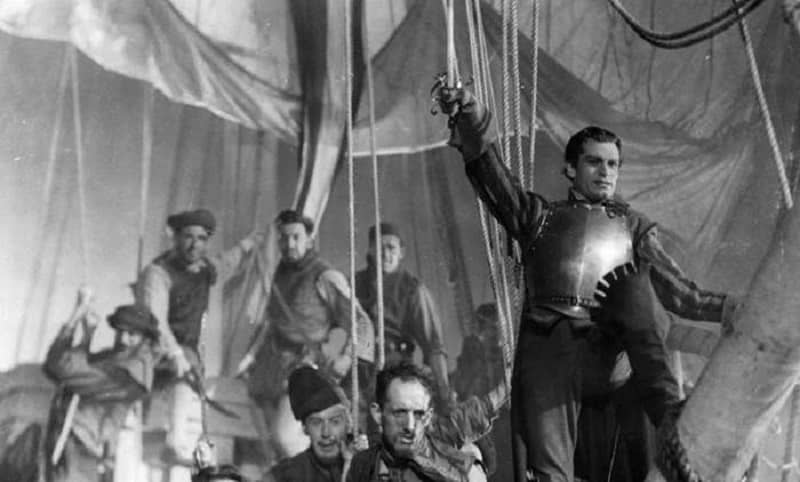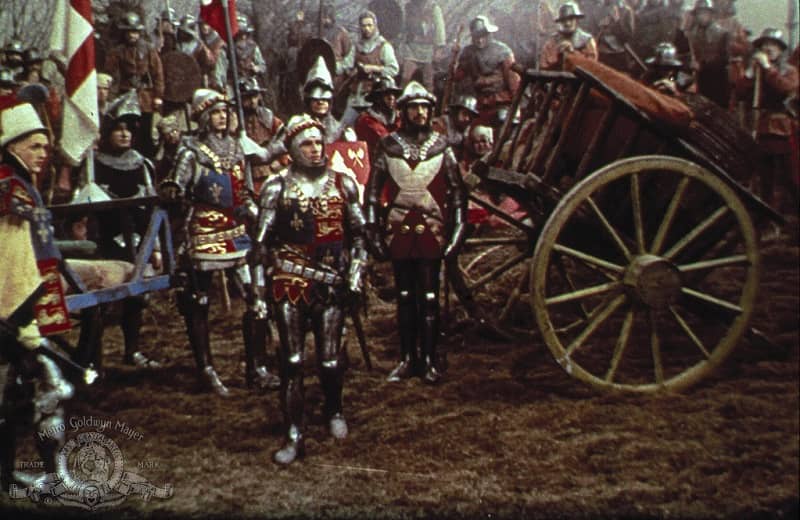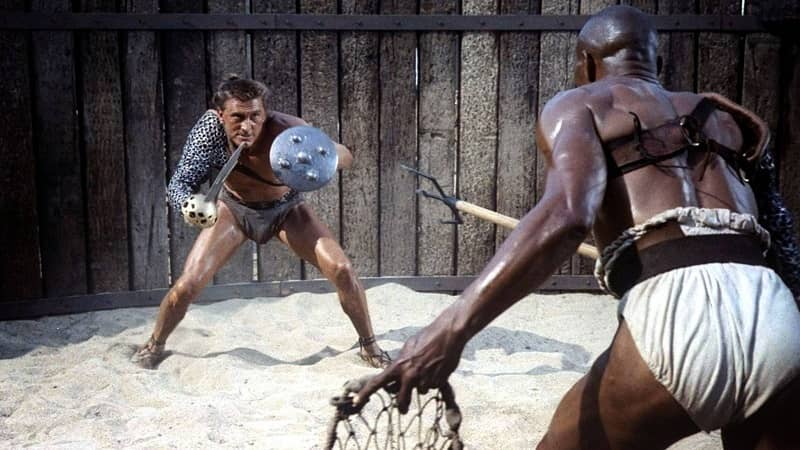Ellsworth’s Cinema of Swords: Laurence Olivier, Swashbuckler?
Laurence Olivier is justly renowned, even revered, as one of the finest actors of the 20th century, and was arguably the greatest English thespian of his generation — which is saying something, since his generation included John Gielgud and Ralph Richardson. Acclaimed as a stage actor, he also appeared in over fifty movies, and happily for us three of them fit under the umbrella of the Cinema of Swords.
Fire Over England
Rating: ****
Origin: UK, 1937
Director: William K. Howard
Source: Nobility Studios DVD
This film was adapted from the 1936 novel of the same name by A.E.W. Mason, the English historical fiction author best known for The Four Feathers (1902). Producer Alexander Korda was looking for a suitably inspiring and cautionary tale that would evoke the rising threat of Hitler’s Germany, and he found it in this story of England’s resistance to Spain’s warmongering King Philip and his invading Armada. Korda was also looking for a vehicle with a romantic subplot to show off his drop-dead gorgeous new stars, Laurence Olivier and Vivien Leigh, who were already lovers off-screen. However, as undeniably attractive as Olivier and Leigh were, this picture really belongs to the actors in the roles of the opposing monarchs: Raymond Massey as King Philip II, and the unforgettable Flora Robson as Queen Elizabeth I.
It’s 1588, mighty Spain threatens tiny England, and at the English Court, Spanish spies are everywhere and their assassination plots threaten the life of the queen. In her audience hall, Elizabeth receives the Spanish Ambassador, come to complain of the raid on Cadiz by Francis Drake, where he burned a Spanish fleet. Robson’s Elizabeth immediately establishes herself as a commanding presence, adroitly alternating between defiance and conciliation; she refuses to reign in Drake and the sea rovers, but gives Spain leave to punish them… “If they can.”
The perilous situation established, cut to a boarding action at sea, where Michael Ingolby (Olivier), in a fine gleaming back-and-breast, leads a crew of English sea dogs onto the deck of a Spanish galleon. But the attack goes wrong, the Englishmen are overwhelmed, and Ingolby and his father the captain are taken to Spain in irons. There, bad turns to worse, and by the time Ingolby escapes to return to England, he has terrible crimes to avenge.
Back in London, all is plots and intrigue. Ingolby is reunited with his beloved Cynthia (Vivien Leigh), one of Elizabeth’s ladies-in-waiting, but their time together is short. After Ingolby saves the queen from an assassin, she gives him a new mission, to impersonate a Spanish agent and return to Spain as a spy.
Madrid: enter King Philip, calmly commanding, “Employ rigorous means. Only by fear can people be made to do their duty — and not always then.” Philip is a cold tyrant, all domineering intellect driven by a frigid religious zeal. In the Palacio Real, a desperate duel of wits unfolds between the suspicious king and the impersonating young spy, a contest that’s a symbol of the war between Spain and England and the fulcrum upon which the whole plot pivots. Philip’s lip curls, complications ensue, swashbuckling happens, and Ingolby hastens back to England just ahead of the sails of the Armada. All the plots and intrigues collide as Robson magnificently rouses her realm to resist the Spanish Armada for the exciting climax, in which Ingolby plays a key part. (Two words: fire ships!)
This is a handsome film, shot by the great Chinese-American cinematographer James Wong Howe, but like most of the pre-war Korda pictures it’s fallen into the public domain, and it’s hard to find a good, clean digital transfer. Nobility Studios have done a painstaking restoration, and it’s their version I recommend. Watch for James Mason in a small, uncredited role as the traitorous Englishman Hilary Vane.
Henry V
Rating: ***** (Essential)
Origin: UK, 1944
Director: Laurence Olivier
Source: Criterion DVD
George MacDonald Fraser, Richard Lester’s screenwriter for The Three and The Four Musketeers, and therefore our patron saint, thought the Olivier version of Shakespeare’s Henry V was the finest movie ever made. It’s a wonderful film, justly celebrated, and there are plenty of sources available that explain why it’s so admirable. For the purposes of this series, we’ll confine ourselves to just two aspects of this classic.
First, the armor: ever since Mark Twain’s A Connecticut Yankee in King Arthur’s Court (1889) had made a mockery of knights in shining armor, it had become the received wisdom that a medieval warrior in full plate was awkward, encumbered, and a lumbering clod when off his horse. Most mid-century Hollywood historical epics paid deference to this idea, showing warriors in heavy armor clanking around ponderously. But the knights and nobles of Henry V wear their plate armor lightly, as if it was tailored for them — as of course it was — seeming completely comfortable and at home while wrapped head to toe in metal, their movements unencumbered, even elegant. More recent scholarship and reconstructions inform us that was, in fact, the way of it: battle armor, though heavy, was made to move and fight in.
Second, there’s the play’s sprawling set piece in the next-to-last act, the recreation of the Battle of Agincourt. In 1944 the Luftwaffe was causing problems in England and even Wales, so Olivier filmed the battle in Ireland, the rolling fields of County Wicklow standing in for the Pas de Calais. Agincourt, a decisive battle in the Hundred Years’ War between France and England, pitted a much larger army of French knights and men-at-arms against King Henry’s badly fatigued force of footmen and English and Welsh longbowmen. The French knights, the flower of European chivalry, charged the English across muddy plowed fields and were slaughtered by the archers. Henry’s men-at-arms then closed in from both sides and the battle became a general mêlée, but the English never lost the upper hand and the French were trounced.
Olivier’s depiction of the battle’s opening scenes was a landmark for its time, unmatched in its clarity and power. The initial charge of the French heavy cavalry draws on Eisenstein’s charge of the Teutonic Knights in Alexander Nevsky, but goes it one better: a tracking camera follows the French vanguard from the side as the knights advance, going from a walk to a trot to a full gallop that seems unstoppable — until they hit the muddy fields and a wall of English and Welsh arrows. The battle then becomes episodic, reverting to Shakespeare’s structure of jumping to encounters between various combatants, English and French, whom we’d been introduced to earlier in the story. It all ends in a final clash between King Henry and the Constable of the French Army, with Henry, of course, victorious.
Watch for Robert Newton — Long John Silver himself — hamming it up as Ancient Pistol, an English hedge-knight who’s become the leader of Prince Hal’s old band of rogues since the death of John Falstaff. He’s hilarious.
Spartacus
Rating: *****
Origin: USA, 1960
Director: Stanley Kubrick
Source: Universal Blu-ray
Spartacus is a meme, of course — but more than that, it’s a remarkable motion picture, arguably the best of the grand historical epics of Hollywood’s studio era. Its subject is the evils of human slavery (and if you’re an apologist for slavery you can stop reading now, because you’re not welcome here). Like all great stories about injustice, it makes the matter relatable by personalizing it into the story of a few representative characters.
The setting is in Italy in 72 BCE, the late Roman Republic, and the three representative characters are Spartacus (Kirk Douglas), a condemned slave being trained as a gladiator, Varinia (Jean Simmons), a slave and body servant at the gladiator school, and Marcus Licinius Crassus (Laurence Olivier), a wealthy Roman senator and would-be dictator. We’re introduced to these characters in the first hour of the movie, which is entirely set at the gladiator school of slave merchant Lentulus Batiatus (Peter Ustinov in the role of a lifetime, but more about him later). At the school the slaves, already treated as mere possessions, are dehumanized even further by being trained to become hopeless machines desperate enough to fight each other to the death for the amusement of the masters. This is depicted in an extended martial skills training montage to end all martial skills training montages; there we first see director Stanley Kubrick’s visual mastery in a bravura sequence that displays his particular kind of genius. The camera starts every scene perfectly placed, and as the scene moves, no matter where the action goes, in close, out wide, slowly or quickly, the camera follows, and at every moment the camera is. Still. Perfectly. Placed.
It’s as well that the story is in the hands of a visual maestro, because for that first hour, Douglas and Simmons barely speak. Douglas might not have had the most expressive face in Hollywood, but Kubrick got him to tell the entire tale of Spartacus’s restrained anguish, fierce spirit, and growing love for Varinia entirely with his eyes. And he’s matched by Simmons, whose eyes were so eloquent she scarcely needed speech. It is, as I said, quite remarkable.
Olivier’s Crassus comes into the picture when he shows up at the gladiator school with his son-in-law and a couple of patrician ladies to demand a private show: a duel to the death. Before the match, Spartacus is asked by his friend Crixus if he would really kill Crixus if he had to, and Spartacus says “Yes.” The fight, which pits Spartacus with a Roman gladius against Draba (Woody Strode), a tall Ethiopian armed with trident and net, is exciting, dramatic, and as authentic as historical research could make it. Spartacus loses to Draba and expects to die, but instead the Black man refuses to kill his fellow slave and sacrifices his own life in a hopeless attack on their masters.
Draba’s sacrifice infuses Spartacus with the principle he lacked and the purpose he needed. When Varinia is sold to Crassus, Spartacus leads a violent revolt that overruns the gladiator school in a few thrilling minutes, and Spartacus is transformed from a sullen slave to the inspiring leader of an ever-broadening slave rebellion. He forges the former slaves into an army with gladiator training and one simple truth: if they all fight together, though they might win or lose, all men and women die, so they might as well die free.
And many die, though for quite a while the rest survive and win. Spartacus’s army grows ever larger as they march toward a port where a hired pirate fleet is waiting to take them away from Italy. This part of the film isn’t perfect; Kubrick does a fine job of putting human faces on the swelling throng of ex-slaves as they march in their thousands toward the sea, but really a little marching-of-thousands goes a long way, and there’s way more than a little. The Romans try to stop Spartacus’s army, but their legions are repeatedly defeated in battles of which we see only the aftermath. After a while this feels like a cheat, but Kubrick knew what he was doing, building the suspense toward one final battle in which all the might of Rome will be arrayed against Spartacus’s vast but ragtag horde. It’s a huge but convincing spectacle, and as confidently filmed as if the 32-year-old director had been making movies about ancient classical warfare for decades.
You know the meme, so you know how it ends — but there’s much more to Spartacus than that. The story of the slave rebellion is echoed by a parallel plot in the Roman senate about the decline of the Republic and the rise of authoritarianism, a plot that pits Crassus against the voice of the plebeians, Gracchus, (Charles Laughton), who is ugly and corrupt but brilliant, with an undeniable, oily charisma. Laughton is tremendous, yet he’s outdone by Ustinov as Batiatus, the obsequious yet engaging scoundrel who moves back and forth between the worlds of the slaves and the patricians; Ustinov won a Best Supporting Actor Oscar for the role, and deserved it.
If you haven’t seen Spartacus, or haven’t seen it lately, you’ll want to watch the 2015 digital restoration of this classic, which includes deleted scenes and composer Alex North’s magnificent full score. Trust me.
The previous installments in the Cinema of Swords are:
Olivia de Havilland — First Queen of the Swashbucklers
Goofballs in Harem Pants
Disney’s Early Swashbucklers
‘50s Vikings – Havoc in Horned Helms
Laughing Cavaliers
Charming and Dangerous: Douglas Fairbanks, Jr.
Eleven Samurai: Early Chambara Classics
Beyond Captain Blood: Three by Sabatini
3 Musketeers + 1 Long Nose
Louis Hayward, Everyman with a Sword (Part 1 of 2)
Days of Technicolor Knights
Louis Hayward, Everyman with a Sword (Part 2 of 2)
LAWRENCE ELLSWORTH is deep in his current mega-project, editing and translating new, contemporary English editions of all the works in Alexandre Dumas’s Musketeers Cycle, with the fourth volume, Blood Royal, just published by Pegasus Books in the US and UK. His website is Swashbucklingadventure.net.
Ellsworth’s secret identity is game designer LAWRENCE SCHICK, who’s been designing role-playing games since the 1970s. He now lives in Dublin, Ireland where he is co-designing a new mobile RPG for the WarDucks game studio.



Another Cinema of Swords and three more great films! And what great villains: Raymond Massey, Charles Laughton, the superb Peter Ustinov and Olivier himself! (Leo Genn played the Constable of France in Henry V but was more of a noble antagonist than an honest villain).
And Jean Simmons as Varinia…wow.
Thank you, Mr. Ellsworth!
We can only mourn the MacBeth we never got; Olivier tried for years to raise the money to film it but with no luck. It was universally acclaimed as his greatest Shakespearian performance.